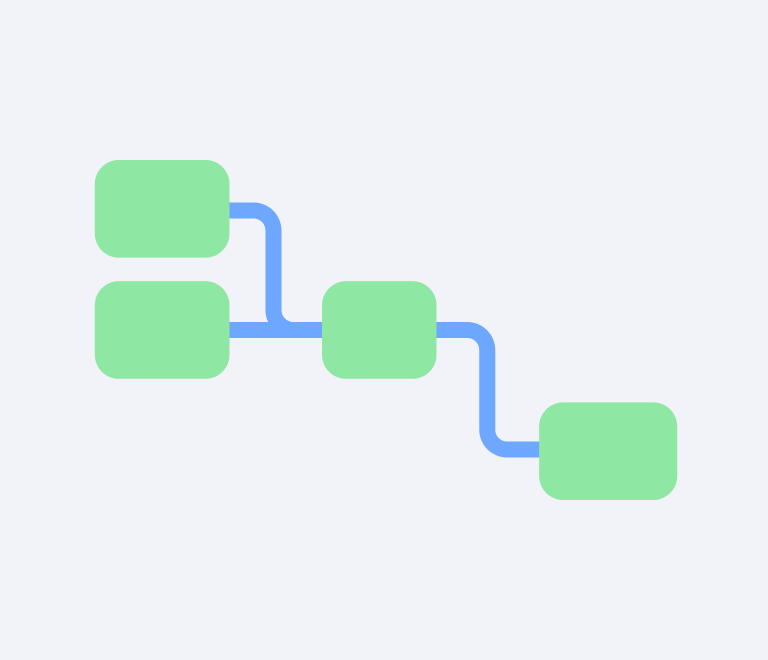What is a Gantt Chart? Definition, Benefits, Examples & Templates
How To Use Critical Path Method in Project Management in 2025
In this article, we are going to dive into the Critical Path Method and explore the ways how you can benefit when applying this technique in your projects.
What is the Critical Path Method?
The Critical Path Method (CPM) is a vital project management technique used to plan, schedule, and control complex projects. Developed in the late 1950s by the DuPont Corporation and Remington Rand, CPM helps project managers identify the longest sequence of dependent tasks (the "critical path") that must be completed on time for the entire project to be finished by its deadline.
CPM is widely used in various industries, including construction, software development, research and development, event planning, and manufacturing. It is particularly valuable for large, complex projects where multiple tasks must be coordinated and managed simultaneously.

Key Components of CPM
Tasks and Activities: Every project is broken down into smaller, manageable tasks or activities. Each task has a specific duration and may depend on the completion of previous tasks.
Dependencies: Tasks often depend on the completion of other tasks. These dependencies must be clearly defined to establish the correct order of activities.
Critical Path: This is the sequence of tasks that determines the minimum project duration. Delays in any task on the critical path will directly impact the project’s completion date.
Slack (Float) Time: This is the amount of time that a task can be delayed without causing a delay to subsequent tasks or the project completion date. Tasks on the critical path have zero slack (float).
What is the Primary Purpose of the Critical Path Method in Project Management?
The primary purpose of the CPM is to ensure timely project completion by highlighting critical tasks whose delays will directly impact the project end date. CPM optimizes scheduling by determining the earliest and latest start and finish times for each task, manages dependencies to ensure prerequisite tasks are completed before subsequent ones begin, and allocates resources efficiently by focusing on critical tasks.
Additionally, CPM provides a framework for monitoring progress, identifying potential delays early, and making necessary adjustments to minimize project duration. By offering a clear visual representation of the project plan, CPM facilitates effective communication with stakeholders about the project’s schedule, progress, and potential risks.
How to Do Critical Path Method

1. Define the Project and Break It Down into Tasks
Identify all the tasks required to complete the project. Break down the project into smaller, manageable components (activities). For each task, note its description, duration, and dependencies.
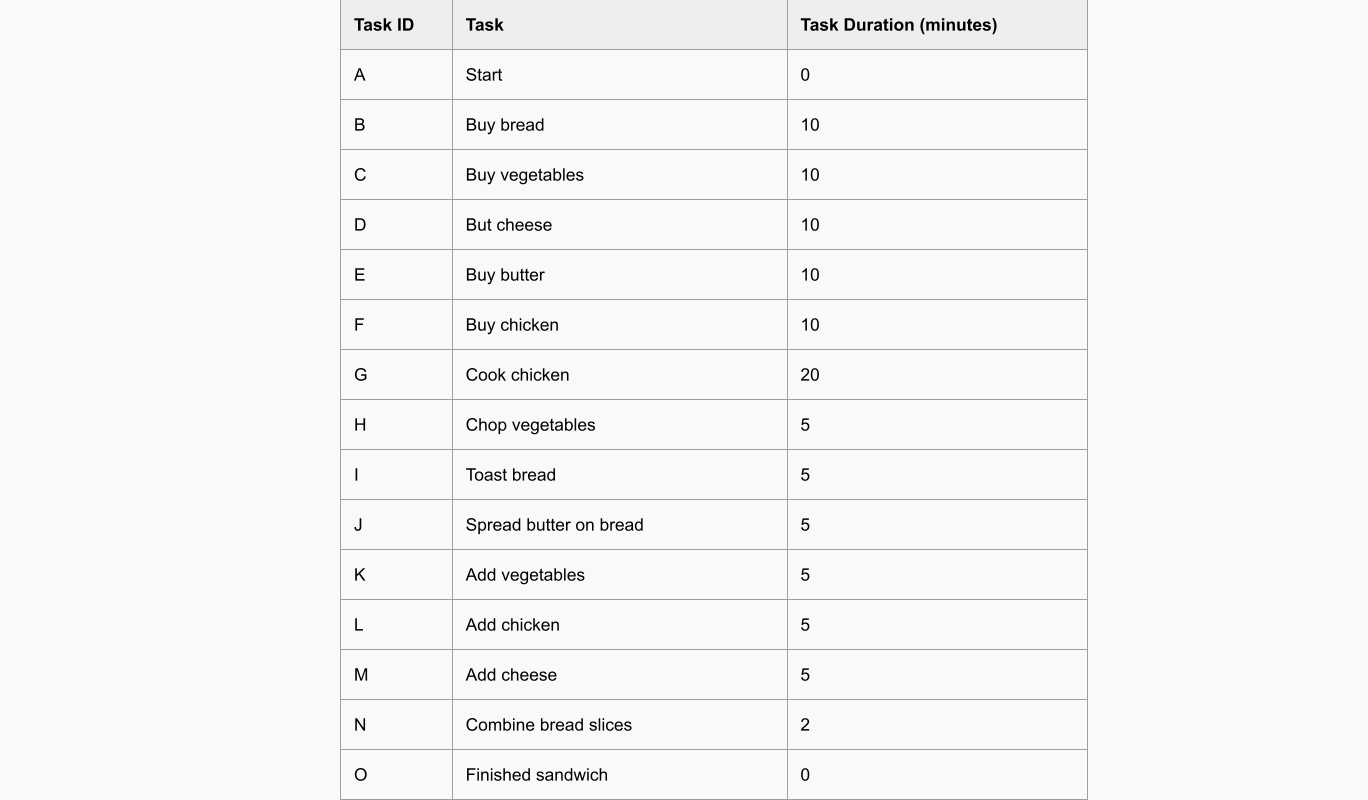
2. Determine Task Dependencies
Establish the order in which tasks must be performed. Determine which tasks must precede others and which can be performed simultaneously.
Types of Dependencies:
Finish-to-Start (FS): Task B cannot start until Task A finishes.
Start-to-Start (SS): Task B cannot start until Task A starts.
Finish-to-Finish (FF): Task B cannot finish until Task A finishes.
Start-to-Finish (SF): Task B cannot finish until Task A starts.
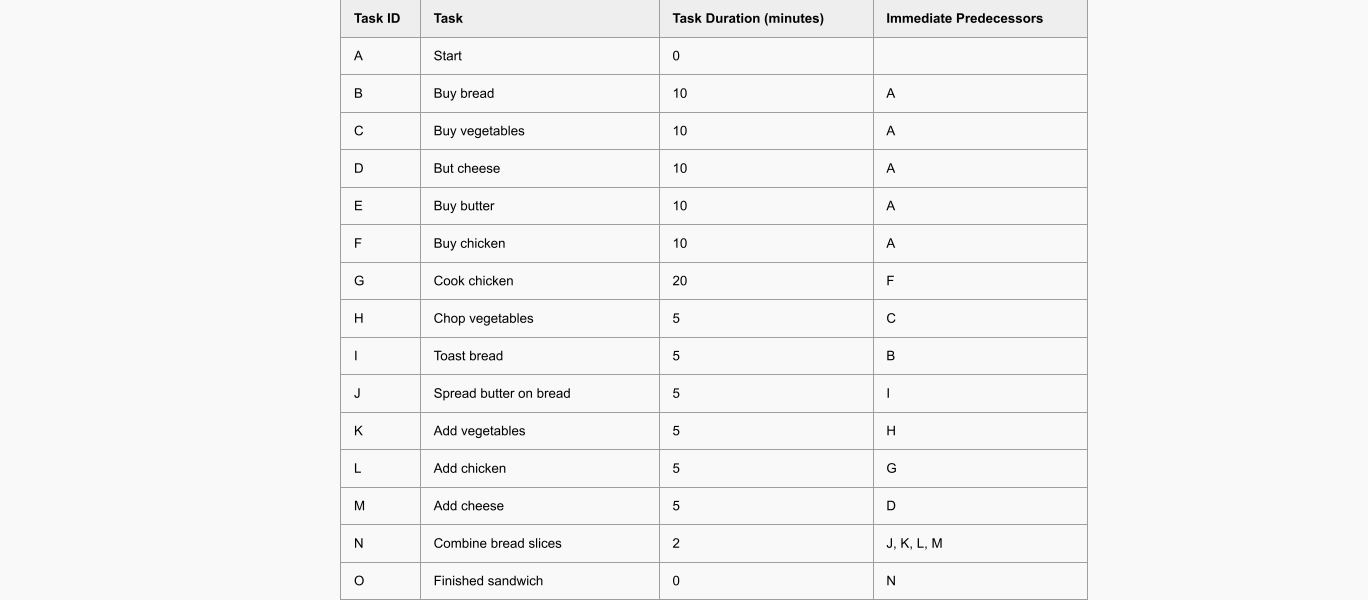
3. Estimate Durations for Each Task
Assign a realistic duration to each task. Durations can be in days, weeks, hours, or any appropriate time unit. If you want to learn more about how to make project estimation, check out our latest blog article.
▶️ Learn everything about how to estimate projects
4. Create the Network Diagram
Draw a network diagram to visually represent the tasks and their dependencies. Use nodes (circles or rectangles) to represent tasks and arrows to represent dependencies.
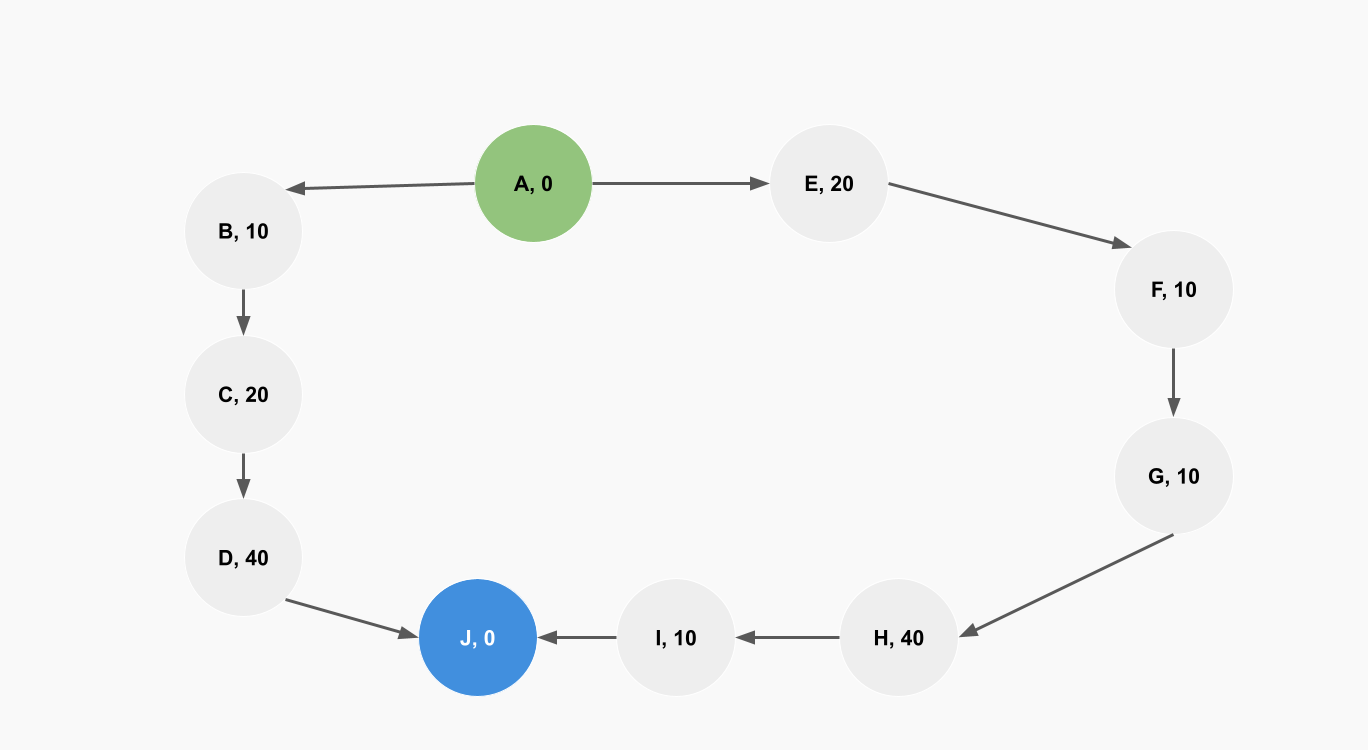
5. Perform Forward Pass Calculation
Calculate Earliest Start (ES) and Earliest Finish (EF) Times. Begin at the project start and move forward through the network diagram.
Earliest Start Time (ES): The earliest time a task can start.
Earliest Finish Time (EF): ES + Task Duration.
Formula:
EF = ES + Duration
ES (next task) = EF (current task)
6. Perform Backward Pass Calculation
Calculate Latest Start (LS) and Latest Finish (LF) Times. Begin at the project end and move backward through the network diagram.
Latest Finish Time (LF): The latest time a task can finish without delaying the project.
Latest Start Time (LS): LF - Task Duration.
Formula:
LS = LF - Duration
LF (previous task) = LS (current task)
7. Identify the Critical Path
Calculate the slack time for each task.
Slack (Float) = LS - ES or Slack = LF - EF
Identify the path with zero slack. This path is the longest path through the network and dictates the project duration.

8. Create the Project Schedule
Use a Gantt chart to visualize the project schedule. It shows task durations, dependencies, and the critical path analysis. Mark key milestones and deadlines on the Gantt chart.
▶️ Learn everything about Gantt chart and see how to build your own
9. Monitor and Update the Schedule
Track progress and update the schedule regularly to reflect actual performance. Recalculate the critical path if there are changes in task durations or dependencies.
How to Calculate Critical Path Method: Real-life Example
Consider a simple software development project and let's make the calculations.
Estimations:
A: Requirements Gathering (5 days)
B: Design (3 days, starts after A)
C: Development (10 days, starts after B)
D: Testing (5 days, starts after C)
E: Deployment (2 days, starts after D)
Network Diagram:
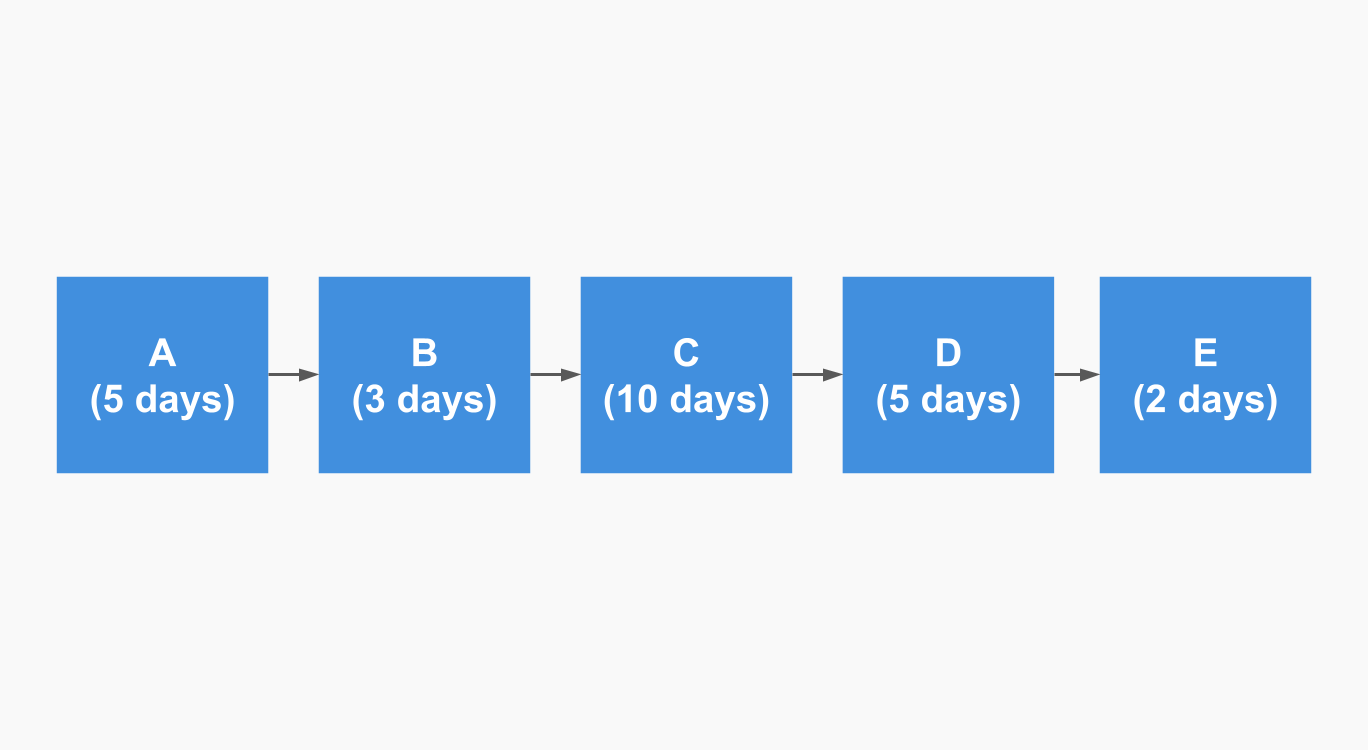
Forward Pass Calculation:
A: ES=0, EF=5
B: ES=5, EF=8
C: ES=8, EF=18
D: ES=18, EF=23
E: ES=23, EF=25
Backward Pass Calculation:
E: LF=25, LS=23
D: LF=23, LS=18
C: LF=18, LS=8
B: LF=8, LS=5
A: LF=5, LS=0
Slack Calculation:
A: Slack = LS - ES = 0
B: Slack = 0
C: Slack = 0
D: Slack = 0
E: Slack = 0
Critical Path:
A -> B -> C -> D -> E
This sequence has zero slack and determines the project's duration (25 days).
Visualize Critical Path on a Gantt Chart
A Gantt chart is a visual project management tool that displays tasks as horizontal bars along a timeline, showing their start and end dates. The critical path can also be represented on a Gantt chart (horizontal critical path method), often highlighted in a different color or style to distinguish it from non-critical tasks. This visualization helps project managers see which tasks are critical for the project's completion and how delays in these tasks will affect the project timeline.
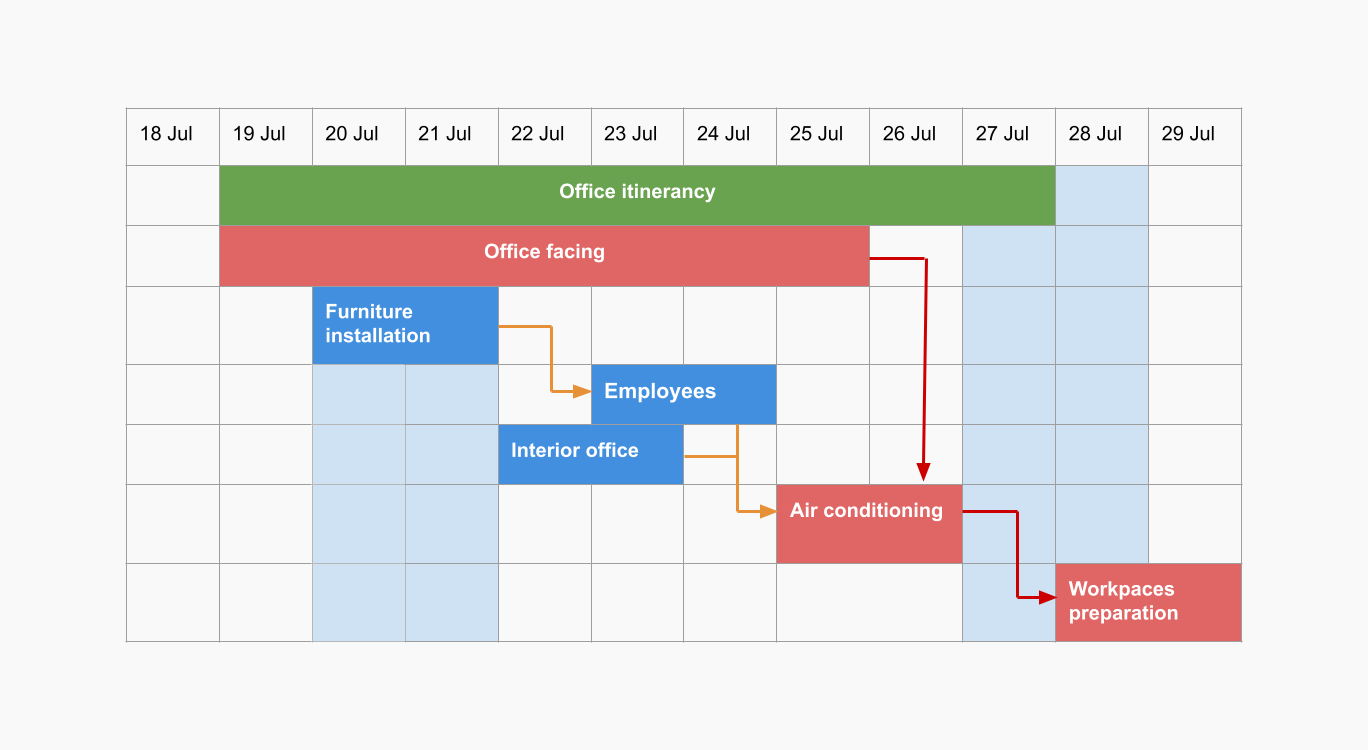
- Create a Gantt chart with a time scale on the horizontal axis and tasks listed on the vertical axis.
- Draw horizontal bars for each task representing their duration, starting from their ES times.
- Connect tasks with arrows or lines to show dependencies.
- Use a different color or style to highlight the tasks on the critical path.
- Ensure that the critical path is clearly distinguishable from non-critical tasks.
▶️ Find a detailed guide on how to create a Gantt chart here
When to Use Critical Path Method
The Critical Path Method (CPM) is particularly useful in certain project management scenarios. Here are some situations where CPM is most beneficial:
- Complex Projects with Many Interdependent Tasks: Helps manage interdependencies and ensure timely project delivery.
- Projects with Tight Deadlines: Prioritizes tasks to meet deadlines, allocates resources effectively, and avoids delays.
- Resource-Intensive Projects: Optimizes resource allocation and ensures availability to prevent delays.
- High-Stakes Projects: Provides structured planning and control, minimizing the risk of project failure.
How Does the Critical Path Method Limit a Project?
While CPM is a powerful tool, it also has its challenges and limitations:
- Complexity in Large Projects: For extremely large projects with many tasks and dependencies, creating and managing the network diagram can become complex and time-consuming.
- Static Nature: CPM assumes a static project environment, which can be a limitation in dynamic and changing projects.
- Estimation Accuracy: The accuracy of the CPM relies heavily on the accuracy of time estimates
Conclusion
The Critical Path Method (CPM) is an essential project management tool that aids in planning, scheduling, and controlling complex projects by identifying the sequence of tasks that determine the minimum project duration. Widely used across various industries, CPM is particularly beneficial for large, intricate projects that require careful coordination and resource management. By breaking down projects into manageable tasks, defining dependencies, and calculating critical paths, CPM helps ensure timely project completion.
Despite its advantages, CPM also presents challenges, such as complexity in large projects, a static nature that may not adapt well to changes, and a heavy reliance on accurate time estimates. Understanding these limitations and incorporating strategies like regular updates, resource management tools, and risk management processes can help mitigate potential issues. Ultimately, CPM's structured approach and clear visualization capabilities make it a valuable technique for ensuring project success and effective stakeholder communication.
About the Author
Violetta Chernobuk is a skilled content strategist and writer at Planyway, specializing in crafting insightful and engaging articles on productivity and project management. With her keen eye for detail and a deep understanding of user needs, Violetta ensures that every piece of content is both informative and inspiring, helping readers optimize their workflows and stay ahead in their projects.
